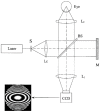Biometric Measurement of Anterior Segment: A Review
- PMID: 32752014
- PMCID: PMC7435894
- DOI: 10.3390/s20154285
Biometric Measurement of Anterior Segment: A Review
Abstract
Biometric measurement of the anterior segment is of great importance for the ophthalmology, human eye modeling, contact lens fitting, intraocular lens design, etc. This paper serves as a comprehensive review on the historical development and basic principles of the technologies for measuring the geometric profiles of the anterior segment. Both the advantages and drawbacks of the current technologies are illustrated. For in vivo measurement of the anterior segment, there are two main challenges that need to be addressed to achieve high speed, fine resolution, and large range imaging. One is the motion artefacts caused by the inevitable and random human eye movement. The other is the serious multiple scattering effects in intraocular turbid media. The future research perspectives are also outlined in this paper.
Keywords: anterior segment; corneal topography; geometric measurement; tomography.
Conflict of interest statement
The authors declare no conflict of interest.
Figures




















Similar articles
-
Comparison of anterior segment and lens biometric measurements in patients with cataract.Graefes Arch Clin Exp Ophthalmol. 2020 Jan;258(1):137-146. doi: 10.1007/s00417-019-04482-0. Epub 2019 Oct 20. Graefes Arch Clin Exp Ophthalmol. 2020. PMID: 31631237
-
Automatic biometry of the anterior segment during accommodation imaged by optical coherence tomography.Eye Contact Lens. 2014 Jul;40(4):232-8. doi: 10.1097/ICL.0000000000000043. Eye Contact Lens. 2014. PMID: 24901975
-
Effect of contact lenses on ocular biometric measurements based on swept-source optical coherence tomography.Arq Bras Oftalmol. 2019 Mar-Apr;82(2):129-135. doi: 10.5935/0004-2749.20190020. Epub 2019 Jan 10. Arq Bras Oftalmol. 2019. PMID: 30726404
-
Anterior Segment Optical Coherence Tomography: Is There a Clinical Role in the Management of Primary Angle Closure Disease?J Glaucoma. 2020 Jan;29(1):60-66. doi: 10.1097/IJG.0000000000001355. J Glaucoma. 2020. PMID: 31490798 Review.
-
Current and potential applications of anterior segment optical coherence tomography in contact lens fitting.Semin Ophthalmol. 2012 Sep-Nov;27(5-6):133-7. doi: 10.3109/08820538.2012.708814. Semin Ophthalmol. 2012. PMID: 23163267 Review.
Cited by
-
The Potential of Selenium-Based Therapies for Ocular Oxidative Stress.Pharmaceutics. 2024 May 8;16(5):631. doi: 10.3390/pharmaceutics16050631. Pharmaceutics. 2024. PMID: 38794293 Free PMC article. Review.
-
Saving of Time Using a Software-Based versus a Manual Workflow for Toric Intraocular Lens Calculation and Implantation.J Clin Med. 2022 May 20;11(10):2907. doi: 10.3390/jcm11102907. J Clin Med. 2022. PMID: 35629035 Free PMC article.
-
Anterior Ocular Biometrics as Measured by Ultrasound Biomicroscopy.Healthcare (Basel). 2022 Jun 24;10(7):1188. doi: 10.3390/healthcare10071188. Healthcare (Basel). 2022. PMID: 35885715 Free PMC article.
-
Design and Performance Characterization of a Novel, Smartphone-Based, Portable Digital Slit Lamp for Anterior Segment Screening Using Telemedicine.Transl Vis Sci Technol. 2021 Jul 1;10(8):29. doi: 10.1167/tvst.10.8.29. Transl Vis Sci Technol. 2021. PMID: 34319384 Free PMC article.
-
Ten Years of Knowledge of Nano-Carrier Based Drug Delivery Systems in Ophthalmology: Current Evidence, Challenges, and Future Prospective.Int J Nanomedicine. 2021 Sep 22;16:6497-6530. doi: 10.2147/IJN.S329831. eCollection 2021. Int J Nanomedicine. 2021. PMID: 34588777 Free PMC article. Review.
References
-
- Bron A., Tripathi R., Tripathi B. Wolff’s Anatomy of the Eye and Orbit. 8th ed. Chapman & Hall Medical; London, UK: 1997.
-
- Schwiegerling J. Field Guide to Visual and Ophthalmic Optics. SPIE; Bellingham, WA, USA: 2004.
-
- Cognard T.E., Goncharov A., Devaney N., Dainty C., Corcoran P. A Review of Resolution Losses for AR/VR Foveated Imaging Applications; Proceedings of the 2018 IEEE Games, Entertainment, Media Conference (GEM); Galway, Ireland. 15–17 August 2018; pp. 1–9.
-
- Davson H. Physiology of the Eye. Macmillan International Higher Education; London, UK: 1990.
-
- LeGrand Y., ElHage S.G. Physiological Optics. Springer; Berlin/Heidelberg, Germany: 2013.
Publication types
MeSH terms
Grants and funding
LinkOut - more resources
Full Text Sources

